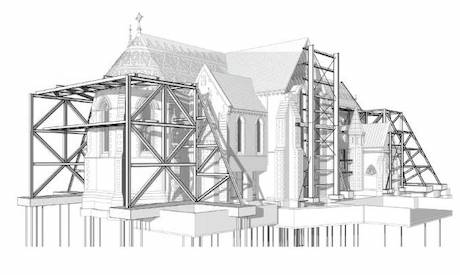It will take a year to complete the stabilisation of the Christ Church Cathedral in Christchurch to a point where people could safely enter the earthquake-damaged building.
Large steel frames will be installed on the west wall, the transepts, the back of the cathedral and the southern side of the building near where the tower once stood.
“These frames are designed to stop the building from moving in an earthquake,” said Project director Keith Paterson
“But they also provide an opportunity for access and then also encapsulate the building to weatherproof it in the future.
We are using them for multiple purposes.”
Workers would then enter beneath portable steel frames to protect them from earthquakes or falling debris.
“It is a bit like Pike River, but the danger isn’t omnipresent, it is a discreet danger.”
Once workers can access the building they will be able to assess the level of damage to the stone walls from a crane, Paterson said.
At the end of the year, demolition will begin on the visitors centre on the northern side of the cathedral to allow more access to the heritage building.
The two-year stabilisation project also includes removing the cathedral’s historic pipe organ so it can be restored and improved.
By the end of the stabilisation stage, Paterson said the building would be about 34 per cent of the current seismic building code.
Three historic trees and the Citizens’ War Memorial should only be removed from the Christ Church Cathedral grounds if absolutely necessary, city leaders say.
Proposed planning laws being drawn up by the Government to fast-track the cathedral’s restoration allow for three, more than 100-year-old, London plane trees and the war memorial to be removed from the site.
The new planning rules being drawn up by the Government would mean resource consent for restoration would have to be approved within 40 days and would not require public notification
Source
- stuff.co.nz
- stuff.co.nz
- Image: stuff.co.nz
